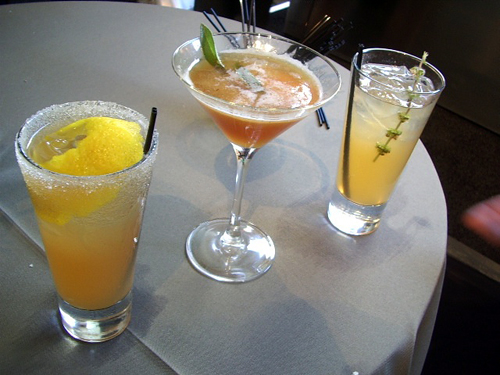
10:30 a.m. on a weekday morning is not my usual cocktail hour. But with a cheerful SF Chefs. Food. Wine volunteer saying "Breakfast is served!" as he placed a cute pink drink in front of me, well, what could I do?
It was, after all, educational. The drink was a raspberry rum daisy, made with white rum, lemon, and raspberries, an olden-days cocktail made artisanally up-to-date through the use of small-batch Caribbean-style Baptiste rum and a locally made fruit syrup sweetened with raw cane sugar and thickened with gum arabic, that secret weapon of molecular gastronomy. And the occasion was Cocktails Get Into the Mix , an exploration of the past and present state of West Coast cocktail culture, moderated by Alcademics editor Camper English. In conversation with English was Duggan McDonnell of Cantina and Thad Vogler of the upcoming Bar Agricole.
Drawing a contrast between the technique-obsessed, traditionalist, authenticity-driven New York style of places like Milk and Honey, Death & Co. and the more free-wheeling, flavor-inspired California vibe, Duggan laughed, admitting, "We're more of a hot mess behind the bar." But both Vogler and McDonnell gave New York City its props, saying they'd both learned a tremendous amount about how even the simplest decisions--what sort of ice to use, whether to double-strain (using a cocktail strainer first, a fine tea strainer second)--can make a dramatic difference in the final result.
But, much like our restaurants, the current West Coast cocktail scene is driven by the extensive, year-round availability of amazing produce. "We eat and drink incredibly well here, we're tasting things constantly," noted McDonnell, who connects this vibrant, terrior-driven food culture with the rise in inventive, market-driven cocktail menus.
These drinks may look simple, but much of the work happens after hours, with bartenders simmering their own herb- or spice-infused syrups, amassing collections of quirky amari (the bitter digestive liqueurs beloved by true cocktail geeks), even growing (or bartering for) herbs, fruits, or seasonings. For bartenders less interested in getting in touch with their inner chef, there's Small Hand Foods run by Jennifer Colliau, a bartender at the Slanted Door, whose Berkeley-based company creates "classic ingredients for pre-prohibition cocktails," including grenadine, gum syrup, orgeat, and pineapple and raspberry syrups. All are made in small batches using raw cane sugar (no corn syrup) and no artificial ingredients.